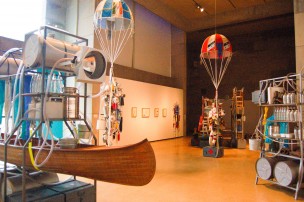Hanging high above the Usdan stairs, the color-blocked “NO BORDERS” flag is hard to miss. So too is the colorful tent weathering strong gusts directly outside. As any good Wesleyan student would, you may have surmised that these installations were the fruits of activism. You’re partly right. Wesleyan’s Ezra and Cecile Zilkha Gallery was honored to welcome a new exhibition featuring the work of Lucy + Jorge Orta that explores an array of socially critical subject matter.
The artistic duo of Lucy + Jorge hail from Paris and Argentina, respectively, and have been making social sculpture for over 20 years. This show is their first major traveling exhibition in the U.S. and the third exhibition curated by Ginger Gregg Duggan and Judith Hoos-Fox in corporation with the Ezra and Cecile Zilkha Gallery.
At the opening reception on Tuesday, Duggan and Hoos-Fox expressed their excitement to finally bring out this exhibition, about which Duggan has been speaking with the duo for over 10 years. The two curators emphasized the idea of social sculpture in the artwork.
“The Ortas follow in the footsteps of Joseph Beuys, who coined the term ‘social sculpture,’ meaning objects that activate the people and the space that surround them,” said Duggan. “These can be as much performances or events as they are sculptures.”
Over 10 staff members from the Environmental Studies, English, and Physics Departments will be writing responses to the exhibition. The collection’s colorful sculptures and their many interactive elements should definitely provide viewers with a more casual and vibrant environment than a quiet art museum or gallery in Manhattan. Whether you’re involved with environmental activism, interested in public art, or simply in need of a space to talk with friends about a new cool topic, Food-Water-Life is an exhibition that can provide all of these things.
“The interactive element may be exactly the reason why we love contemporary art so much,” Visiting Professor of History Richard Kagan, a long time art lover and collector, said about the exhibit.
There is something special about the simple practicality and intimacy of the Ortas’ sculptures. A certain degree of abstraction in art, even art that deals conceptually with current affairs, can work against getting its message across. Food-Water-Life’s more literal, less interpretive approach to socially critical art is effective in this case.
The Ortas forge a direct connection between each composition and its meaning. For each, porcelain plates, wiry shopping carts, and metal utensils are all indicative of food, while giant jugs, glass bottles and silver canteens capture the essence of water. Here, conventional, everyday products successfully speak to audiences about important global issues, proving that modern art does not have to be completely abstract to convey a message.
“It’s pretty amazing that the artists have combined the actual daily function, or instrumentality of the object, with the metaphoric function of an artwork,” said Duggan.
It is worth noting that the full-scale canoe docked in the center of Zilkha has a sister canoe that the Ortas have installed at the Shanghai Biennale, where it is a fully-working water purification system. The Museum of Contemporary Art is pumping in water from the Huang Pu River up 20 meters into the museum’s third floor. It is purified in a bamboo “factory” and then made available for the visitors to taste, enjoy, and take away in a specially designed OrtaWater bottle.
Overall, the exhibition brings to the surface many important global issues through creative means that are both thought-provoking and aesthetically pleasing.

Comments are closed